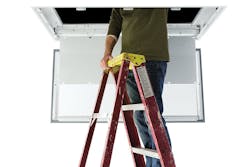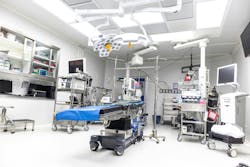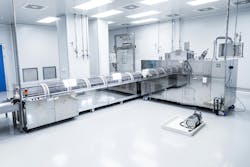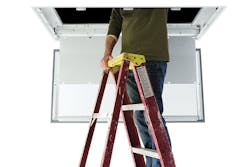Construction projects within the technology and health care sectors often require changes in architecture that support delicate and sensitive work. While this cleanroom-like construction method is not new, it is expanding. For instance, according to Deloitte, in most modern hospitals, there are at least a dozen cleanrooms. Many industrial spaces have also adopted cleanroom designs. The sectors aim to increase the quality of a product, improve outcomes for patients, reduce contamination, and/or maintain a sterile field. When cleanliness is the goal, it must start at the top.
The ceiling is — and always has been — the source of air. However, it is now common to also use the ceiling to support technical equipment. Think of a surgical suite where devices previously on rolling carts are now attached to the ceiling (Photo 1). Since some processes critical to the space are happening above the ceiling — an area we call the plenum — many new reasons now exist to enter the plenum.
Historically, servicing this equipment relied on simple, lay-in grid ceilings. However, those days are gone. These clean environments now require sealed, locked-down panels or solid ceilings, according to Chapter 3, “The Role of Technology in the Connected Ecosystem,” of the FDA Food Safety Modernization Act. To the building owner, facility manager, and construction team, these changes mean that once the ceiling is in place, free access to the area above the ceiling no longer exists (Photo 2).
Lighting helps solve maintenance access challenges.
Often, a dedicated access panel is installed in the ceiling to allow access to the plenum space. However, each opening creates a potential source of contamination as well as an additional cost. These ceilings are often complicated, with luminaires and filters both requiring space in the ceiling. Often, a single access panel is insufficient. Additionally, sending someone to crawl into the space risks violating OSHA’s Confined Spaces safety rules, CFR 1910.146.
To meet this challenge, forward-thinking lighting manufacturers have created plenum-access luminaires that provide access to the equipment above the ceiling via a sealed, removable panel within the luminaire itself (Photo 3). This design helps simplify the ceiling layout, prevents the disruption caused by removing a luminaire, and permits the room’s quick return to full function.
Reducing plant downtime
Each year, millions of dollars of capital improvements are made to facilities and equipment to increase product safety, protect employees, and reduce costs. This is a critical expenditure because equipment in a typical food processing plant often runs 16 to 24 hours per day, seven days per week. Equipment failure is the most common cause of plant downtime. The longer it takes plant personnel to respond to and repair equipment, the more damaging the interruption to the business. As such, systems that are not operating at maximum speed create a domino effect that can result in missed deadlines, lost revenue, and disappointed customers.
According to Deloitte, poor maintenance strategies can reduce a facility’s overall productive capacity by 5% to 20%. Recent studies also show that unplanned downtime is costing industrial manufacturers an estimated $50 billion each year, according to the article, “Predictive Maintenance and the Smart Factory.” For maintenance and facility managers, the mere utterance of the words “unplanned downtime” often elicits panic. To compensate for this, facility managers and company leadership must find innovative ways to solve the root cause of such problems.
Sealed luminaires
The need is greater than ever to optimize equipment reliability to maximize uptime and productivity. According to a 2018 McKinsey & Company report, “Customers are demanding machines that improve operational efficiency, cut costs, and increase uptimes…”
While plant managers are typically focused on line production equipment, food processing companies can help reduce food-borne illnesses, and lessen operating costs and unplanned downtime through the use of sealed luminaires. Innovative infrastructure solutions like sealed LED luminaires can ensure sanitation regulations are met, and maintenance above production lines is minimized, which reduces downtime and addresses this pressing challenge.
A well-designed sealed enclosure, utilizing high-quality construction and materials, virtually eliminates the risk of contamination and the need for frequent maintenance. Taking it a step further, luminaires with a nonporous, sealed design ensure they remain free of corrosion, dust, dirt, insects, moisture, and bacteria. This sealed luminaire design also helps reduce costly unscheduled maintenance and downtime by protecting the luminaire’s internal components.
Plant illumination and standards
Due to related health and wellness concerns, food processing plants must pay close attention to food safety. Typically, this involves power washing and sanitizing equipment. Food manufacturing facilities must follow many stringent USDA regulations, including those involving the presence of glass in the facility. When handled incorrectly, glass, such as that in some luminaires, poses the threat of contamination. Specifically, the Food and Drug Administration (FDA) requires that sealed enclosure luminaires be certified to Ingress Protection (IP) and National Sanitation Foundation (NSF) standards to reduce the risk of contamination and avoid costly disruption of work due to unscheduled maintenance.
The purpose of the food equipment standard is to establish minimum food protection and sanitation requirements for the materials, design, fabrication, construction, and performance of food handling and processing equipment, including luminaires. To ensure safety and reduce maintenance, the FDA has developed certifications and standards. For example, relative to lighting in the food processing plant, the light should be:
- Easy to clean.
- Made of smooth, hole-free, and corrosion-resistant material.
- Designed to reduce the ingress of dust, debris, pests, and other possible hazards.
In addition to the food equipment standard, color rendering guidelines have been established to help ensure proper product examination during quality inspections. Food processing environments are also required to have the correct amount of illumination at each task location. To comply with the stringent standards set by the USDA, FDA, and Illuminating Engineering Society (IES), a minimum color rendering index of 85 is recommended in instances where color rendering is critical.
Maintaining sanitation
The Food Safety Modernization Act has transformed the nation’s food safety system by shifting the focus from responding to foodborne illness to preventing it. Product recalls cost food and beverage companies millions of dollars each year, but 56% of 2019’s recalls across the United States, United Kingdom, and Ireland were preventable, according to the FDA Food Safety Modernization Act. Processors must commit to improving equipment hygiene. However, keeping equipment clean presents challenges, which manufacturers can help overcome.
Food processing plants are a very difficult environment for luminaires to endure due to the daily cleaning and sanitizing. Harsh chemicals like sodium hydroxide and other caustics are used to clean equipment and can be extremely corrosive to luminaire housings. In addition to caustic chemicals, high-pressure water spray is used — sometimes up to 1,000 psi. While this ensures all contaminants are removed, unsealed luminaires allow the ingress of water, causing extensive damage.
Sealed enclosure luminaires, however, prevent both the ingress and egress of dust, fungus, bacteria, and other contaminants that might put processes and people at risk. Additionally, NSF P442 requires stringent pressure testing and third-party certification to prove that luminaires are qualified for clean industrial applications: They must prevent the flow of air between the plenum space and the controlled environment, be protected from contaminants, particulates, and moisture, and be easily cleanable. This protocol is very difficult to achieve but proves that a luminaire is truly leak-proof and ready for use in the most challenging environments. Not every situation demands this protocol — for those that do, look for the NSF P442 certification.
Innovation mitigates challenges
To meet industry requirements, reduce unplanned downtime, and improve operational efficiencies — whether that’s in a health care or processing plant setting — facility managers need to consider innovative technology. As electrical contractors, it’s critical to know the latest and most advantageous technologies available because you play a unique role when servicing challenging projects, as an unbiased, honest broker working in your client’s best interest. Providing invaluable counsel regarding the most effective lighting solution to address unique project challenges positions you as a trusted, collaborative, and well-respected partner.
About the Author
Tim Stevens
Tim Stevens is a senior product manager with Kenall Manufacturing and may be reached at [email protected].



